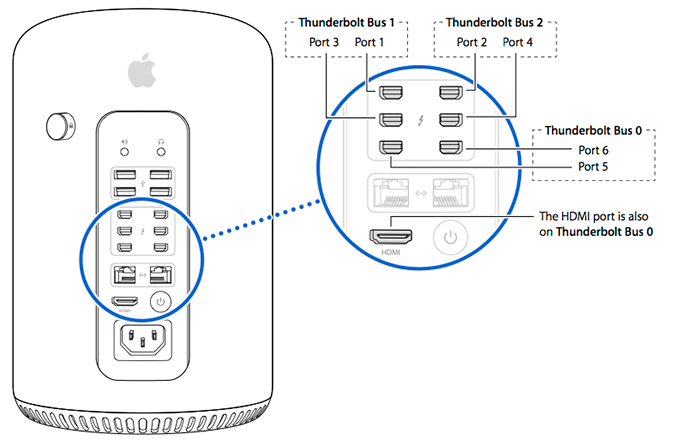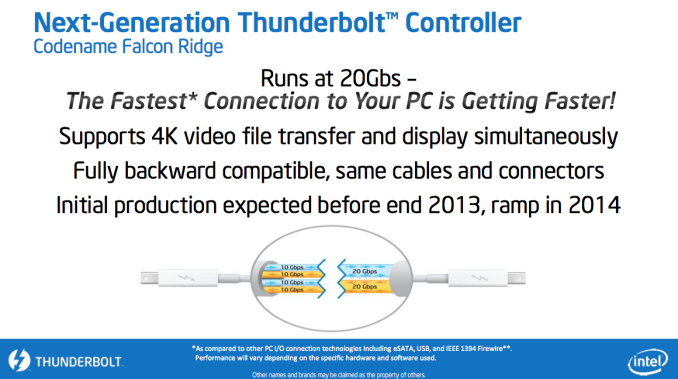The Mac Pro Review (Late 2013)
by Anand Lal Shimpi on December 31, 2013 3:18 PM ESTThunderbolt 2
The new Mac Pro integrates three Intel Falcon Ridge Thunderbolt 2 controllers. These are the fully configured controllers, each supporting and driving two Thunderbolt 2 connectors on the back of the Pro for a total of 6 ports.
Pairing Thunderbolt 2 with Ivy Bridge EP is a bit tricky as Apple uses Thunderbolt 2 for display output as well as data. Typically you’d route all display through processor graphics, but in the case of IVB-EP there is no integrated graphics core. On a DIY PC you enable display output over Thunderbolt 2 by running an extra cable out of the discrete GPU and into a separate input that muxes the signal with PCIe and ships it out via another port as Thunderbolt. Here’s where Apple’s custom PCB work comes in handy as all of this is done internal to the Mac Pro. The FirePro’s display outputs are available via any two of the six Thunderbolt 2 ports, as well as the lone HDMI port on the back of the Mac Pro.
How does Thunderbolt 2 differ from the original? For starters, it really would’ve been more accurate to call it Thunderbolt 4K. The interface is fully backwards compatible with Thunderbolt 1.0. You can use all previous Thunderbolt peripherals with the Mac Pro. What’s new in TB2 is its support for channel bonding. The original Thunderbolt spec called for 4 independent 10Gbps channels (2 send/2 receive). That meant no individual device could get access to more than 10Gbps of bandwidth, which isn’t enough to send 4K video.
Thunderbolt 2 bonds these channels together to enable 20Gbps in each direction. The total bi-directional bandwidth remains at 40Gbps, but a single device can now use the full 20Gbps. Storage performance should go up if you have enough drives/SSDs to saturate the interface, but more importantly you can now send 4K video over Thunderbolt. Given how big of a focus 4K support is for Apple this round, Thunderbolt 2 mates up nicely with the new Mac Pro.
So far I’ve been able to sustain 1.38GB/s of transfers (11Gbps) over Thunderbolt 2 on the Mac Pro. Due to overhead and PCIe 2.0 limits (16Gbps) you won’t be able to get much closer to the peak rates of Thunderbolt 2.

The impact of chaining a 4K display on Thunderbolt 2 downstream bandwidth
Here’s where the six Thunderbolt 2 and three TB2 controllers come into play. Although you can daisy chain a 4K display onto the back of a Thunderbolt 2 storage device, doing so will severely impact available write bandwidth to that device. Remember that there’s only 20Gbps available in each direction, and running a 3840 x 2160 24bpp display at 60Hz already uses over 14Gbps of bandwidth just for display. I measured less than 4Gbps of bandwidth (~480MB/s) available for writes to a Thunderbolt 2 device downstream from the Mac Pro if it had a 4K display plugged in to it. Read performance remained untouched since display data only flows from host to display, leaving a full 20Gbps available for reads. If you’re going to connect Thunderbolt 2 devices to the Mac Pro as well as a 4K display, you’ll want to make sure that they aren’t on the same chain.
If we start numbering in the top left corner of the 2 x 3 array of Thunderbolt ports and go left to right down the stack, you'll want to first populate ports 1, 2 and 5 before filling in the rest. The diagram below should help simplify:












267 Comments
View All Comments
akdj - Wednesday, January 1, 2014 - link
This is what you gleaned from such an insightful review....of a revolutionized desktop computer from Apple? Seriously? He was running a GPU and CPU 'poison' in order to find the ceiling. NOTHING in his real world testing including editing, rendering and transcoding 4k video increased core temps dangerously, nor did they spin the fans up audibly (a quiet room is typically 40-45dB). Wow. Amazing comprehension. Guess it fits with your 'name'Morawka - Wednesday, January 1, 2014 - link
the very next paragraph he reached the same power use and same thermal throtteling using a "normal 4k workload", he just didnt go back and correct his first paragraph about it not being able to hit that ceiling on normal workloads.damianrobertjones - Thursday, January 2, 2014 - link
"of a revolutionized desktop "Oh please stop. It's just a desktop with x or y and nothing amazingly special.
akdj - Friday, January 3, 2014 - link
"It's just a desktop with x or y and nothing amazingly special."....lol. Are you 16? I'm 43....and THIS is a revolution in desktop technology, power, size, speed, aesthetics, storage, expandability and power efficiency. 'X' and 'Y' are pretty F'ing 'significant' IMHO. Oh....yeah....it's Rev A. A baby. As a user of ridiculously large boxes, servers and heavy monitors over the years----to call it anything BUT revolutionary is ignorant. Revolutionary doesn't always have to equal success immediately---but with the decline in desktop sales...but still the 'need' to have desktop power, it's pretty cool someone thought outside of the 'box'tyaty1 - Wednesday, April 1, 2015 - link
While the design is intuitive, any kind throttling is unforgivable in this price range. The old Mac Pro did not do that, even a skillfully home-built desktop computer wont to that either.It is not desktop computer , but a workstation. It needs to serve its purpose without fault, no more no less.
Apple stepped into the consumer line too much, and it works them well, but it negatively impacts the business/professional customers.
Morawka - Wednesday, January 1, 2014 - link
hell i dont think the cooler surface area is a problem, i think the Black Chassis, Black Cooler, Black PCB are all whats causing the high temps. they should have left the thermal core pure copper and not used any anodizing. Black keeps heat in!name99 - Wednesday, January 1, 2014 - link
I guess you're unfamiliar with the concept of black body radiation...jasonelmore - Thursday, January 2, 2014 - link
i am, but reading the wiki on "black body radiation" i fail to see how it applies to this Mac Pro.wallysb01 - Friday, January 3, 2014 - link
Things colored black radiate (and absorb) heat faster than other colors. Black body radiation has nothing to do with things actually being black.Ppietra - Friday, January 3, 2014 - link
black body radiation refers to the kind of radiation that a body emits due to its temperature.Most thermal radiation (at this kind of temperatures) is infrared, so it doesn’t matter what is the visible color of the objects surrounding the "hot" object.
But even if the "hot" body emitted significant visible light, the black color of the surrounding objects would actually help absorb that energy which would then be dissipated as infrared radiation or by heat transfer to the air or other objects